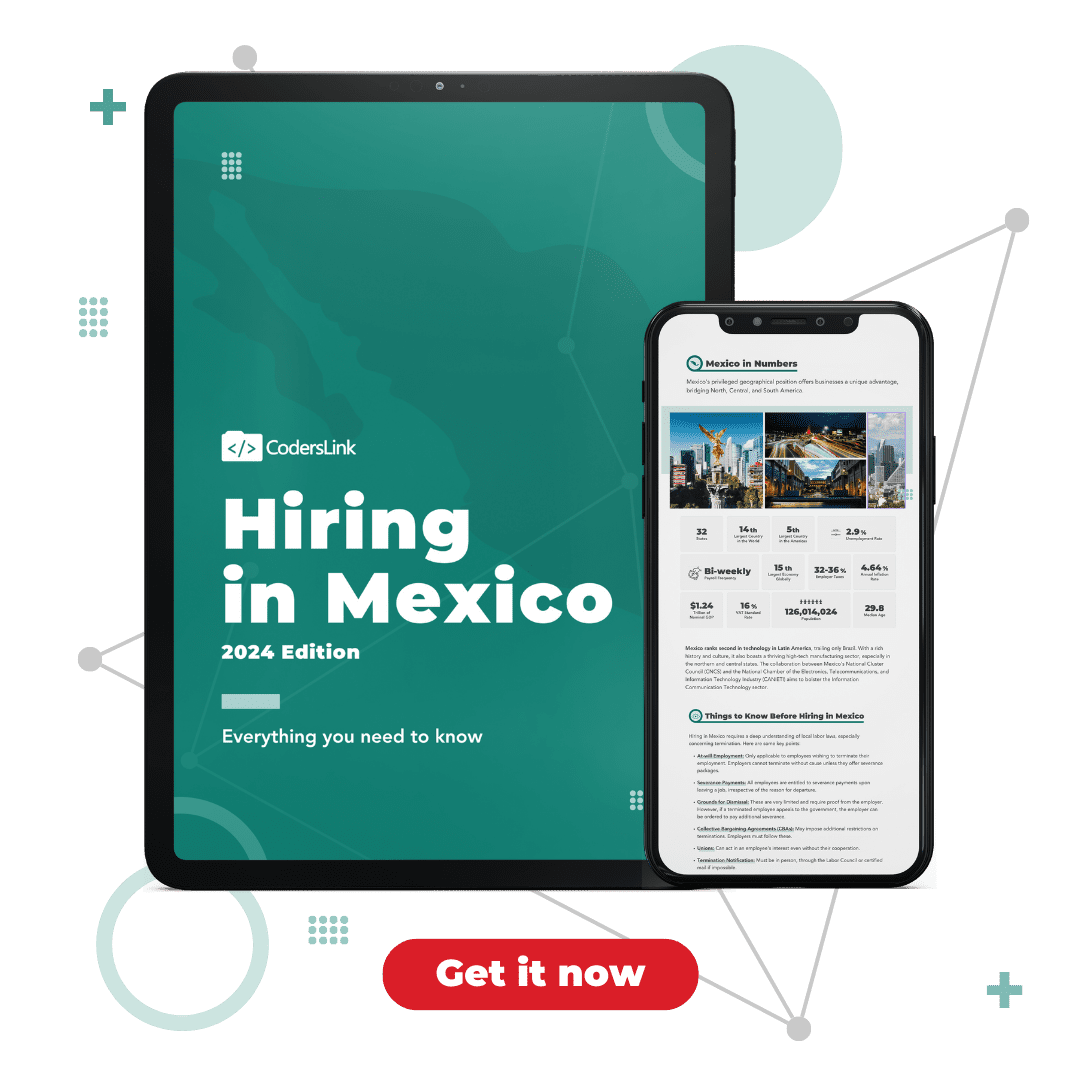
Leaping into a new and exciting talent market?
There are some exciting prospects in the growing tech ecosystems of Latin America.
Today’s market is competitive, fast-paced, and very specialized. Companies and hiring managers have to be proactive about their hiring process to avoid a high turnover rate or mis-hire.
So, what should hiring managers keep in mind when it comes to hiring in a region like Latin America?
What are Hiring Managers Looking for When It Comes to Tech Talent?
Broadly speaking, hiring managers tend to look for a couple of characteristics: technical skills, soft skills, and cultural fit.
These are, of course, broad categories. So, let’s dig deeper into the hiring process of tech professionals in the current landscape. More specifically, what does it mean for a company to hire in Latin America and how can they approach the process with the most insight and information possible for a successful outcome?
Challenges in Tech Hiring in the U.S. and Elsewhere
Hiring tech talent comes with a unique set of challenges because of how competitive and —at times— specialized and niche the positions can be. Some of the biggest challenges that U.S. hiring managers and companies report have to do with high attrition and turnover rates, economic conditions, how time-consuming the process is, the heightened competition, and the increase in salary costs.
In 2023, a study by an HR firm reported that the average hiring process takes an average of 44 days. This was a general average and does not account for the difficulties in filling specialized tech roles. A 2021 LinkedIn study showed that engineering was the position that took longer to fill with other technical positions in research, finance, and information technology following close behind at 48, 46, and 44 days on average to fill.
With the time to hire being so long, ensuring the most efficient and effective hiring process is essential for companies.
What Does LATAM Tech Talent Value in the Interview Process?
Recent survey data shows that technical professionals in Latin America have similar concerns and views on the hiring process as their U.S. counterparts. For example, a 2021 Stackoverflow survey showed that about 54% of respondents who were not actively looking for new employment were open to new opportunities. In total about 74% of U.S. tech professionals were open to new job opportunities.
In Mexico, our 2023 Tech Salaries survey showed that 49% of respondents planned on changing jobs. This implies that about half of tech professionals were excited or open to the possibility of finding new work. At the same time, when asked about satisfaction with work, 62.8% said they were satisfied, 27% said they were indifferent, and 10% were dissatisfied.
In general, it seems that technical professionals are open to finding new opportunities when their current job doesn’t offer the growth or benefits they seek.
In Mexico, for example, tech professionals:
- Think the ideal time frame for a tech interview process is about 2 weeks
- Value feedback after the interview process regardless of the outcome.
- 92.9% of tech professionals agree with being technically evaluated for tech roles and/or in interviews
How Does LATAM Tech Talent Look for New Opportunities?
Mexican tech professionals use a variety of methods to look for job opportunities. Like in the United States, there are several different ways tech workers can seek out exciting new jobs. In Mexico, our survey revealed that most tech workers look for opportunities on their own through various channels. About 29%, however, seek help from either a recruiter or agency to connect with new opportunities.
How Mexican Tech Professionals Prefer Looking for Work
| Individually | 70.2% |
| Through a hiring agency or other entity | 12.2% |
| With the help of a professional | 17.6% |
How is LATAM Talent Different from U.S. Tech Talent?
Technical professionals in the U.S. and Mexico share similarities and differences when it comes to their preferences and their views on the hiring and onboarding process.
Both U.S. and Mexican tech professionals find that onboarding is essential for a smooth landing in a new company. Data suggests that effective onboarding can improve employee retention by as much as 25%.
In late 2022, Forbes posted a list of some of the top reasons technical talent leave their current employment for greener pastures. The top reasons were as follows:
- Not invested in the company’s mission
- They don’t feel engaged
- Burn out
- They don’t have the resources they need to succeed
- No investment in their growth
- Lack of skills development or growth opportunities
Our Mexico Tech Salaries Report 2023, painted a similar picture.
Mexican tech professionals often left their jobs for better salaries but also for better growth opportunities and more engaging challenges at work.
Other Cultural Similarities and Differences
Similarities
- Seek an efficient and reasonable interview process. Tech professionals across all geographic regions prefer an interview process that is efficient and doesn’t have endless rounds of interviews.
- Tech professionals like to talk with hiring managers or other engineers who know the positions.
- Cultural similarities that uphold strong work ethic and value company culture.
- There is a lot of cultural overlap between Mexico and the U.S. because of the proximity.
Differences
- There are some cultural differences between LATAM talent and U.S. talent. For example, in Mexico business communication might often be a little less direct, while American workers tend to opt for direct and upfront discussion.
- Mexico tech professionals do not seek out equity as part of their ideal benefits package. In Mexico, the concept of equity doesn’t hold as much weight as it does in America.
- The Mexican work culture is very team-oriented. In a business setting, Mexican workers tend to uphold the needs and goals of the company above their own. In the U.S., workers might be a little more individualistically-minded and prefer independence and autonomy.
Other countries in Latin America are similar to Mexico in some of their cultural traits. For example, both Brazil and Argentina are very people-oriented cultures that work well in team settings and approach problems with a team mindset. Read more about some of the workplace cultures in Argentina and Brazil in our blog post about Mexico and the LATAM tech ecosystem.
Interview Questions to Evaluate LATAM Tech Talent
Every company’s interview process is different and emphasizes different types of skills or abilities. Companies often break up the questions into technical questions and questions oriented toward identifying soft skills.
Soft-Skill and Cultural Fit Evaluation Questions:
When interviewing a software developer or engineer from another country, it’s good to keep in mind that they come from a different culture and therefore may have a unique approach to problems or team settings. To get a better idea of whether your candidate would be a good fit, here are a few key points to consider:
- Work dynamic. You want to get an idea of the type of work dynamic and setting that a candidate is comfortable and familiar with.
- Example questions: How would you describe your ideal work environment?
- Work style. It’s a good idea to get a sense of the type of work personality that a candidate possesses. That is, whether they like to work independently or are much more comfortable with collaboration and a supportive environment.
- Example question: Do you prefer working independently or as part of a team?
- Ability to work with culturally varied teams. Many LATAM candidates already have experience working with international companies and multicultural teams. It’s good to get some feedback on their experience in such settings or to assess their viewpoints regarding this type of work arrangement.
- Example question: Do you have any experience working with culturally diverse teams? What was your experience like and how did you go about collaboration?
- English proficiency. Every company uses a variety or combination of various communication tools and strategies. Understanding the candidate’s experience in communicating in English will provide you a more three-dimensional view of their English proficiency and ability to collaborate in their second language.
- Example questions: What communication tools have you used in the past and how would you describe your comfort level with written communication in English?
- Work structure and workflow. Many software development teams in the U.S. frequently use the Agile framework. Mexico has a high rate of adopting this framework as well and, therefore, most of the talent is highly proficient in this work philosophy. It’s good to get an idea of how their teams have structured their projects in the past to see where their understanding is of your company’s particular workflow.
- Example questions. What is your attitude towards working in an Agile environment? Are you familiar with the Agile framework and how would you characterize your comfort level with it?
Technically-Oriented Questions:
The technical questions may go hand-in-hand with a technical assessment or take a broader approach to a candidate’s technical knowledge. The questions will also vary depending on whether you are hiring an entry-level, mid-level, or senior software developer or engineer.
- How would you explain the concept of cloud computing?
- What programming languages have you used and in what capacity or types of projects have you used them?
- What was the last project you worked on and what was your role?
- What is your process for debugging or checking code to ensure it can handle different error situations?
Work With a LATAM Expert to Find the Best Candidates for Your Roles
Filling tech roles is not an easy task. It becomes particularly difficult in a very competitive labor market and—as is the case in the U.S.— demands very high salaries. Working with LATAM talent means that companies can access high-caliber talent without the rising salaries in the United States. A comparison of salaries by role provides an accurate picture of the differences in salary amounts in the two countries. Working with a new market, however, means that there are nuances to navigate.
Our team guides you through the process and leads you to the best talent in the region. Learn more by talking to one of our team members about the potential of the Mexican tech labor market.


